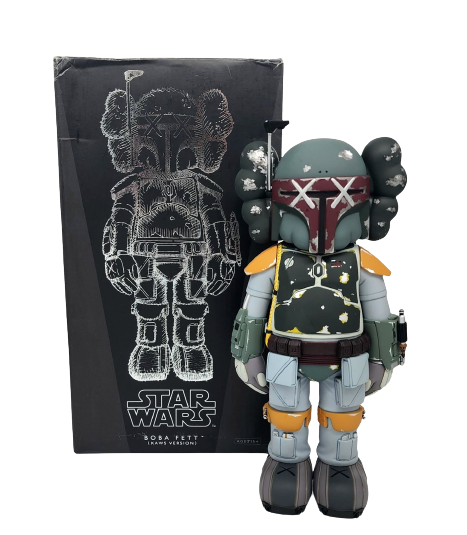
Gray/Grey
-

Kaws- Brian Donnelly Star Wars Boba Fett Companion Fine Art Toy by Kaws- Brian Donnelly
Star Wars Boba Fett Companion Ultra Rare Authentic 2013 Limited Edition Painted Vinyl Art Toy Figure Sculpture Collectible Artwork by Artist Kaws- Brian Donnelly x OriginalFake. 2013 Limited Edition of 500 Chum Companion Painted Vinyl Size 10.5 x 5 x 3.5 Printed On Foot. Displayed With Box, Extremely Fine Example, Box in Great Condition. Stamp Perfect. Pictures Of Actual Example. Authenticated With Seals and Unique Tracking Serial Number Included. KAWS' Boba Fett Companion: A Cultural Icon in Street Pop Art The Boba Fett Companion by KAWS, the pseudonym of artist Brian Donnelly, is a rare and authentic piece that seamlessly bridges the gap between pop culture and high art. Released in 2013 as a limited edition of 500, this painted vinyl art toy is a notable work within collectible artwork. The piece is a 10.5 x 5 x 3.5-inch sculpture that embodies the iconic Star Wars character with the distinctive stylings of KAWS. It's a piece that appeals to fans of the legendary sci-fi series and lovers of street pop art and graffiti artwork. Detailing the Authenticity of KAWS' Work The Boba Fett Companion exemplifies fine detail and craftsmanship, distinguishing authentic pieces from imitations. Each figure is authenticated with seals and a unique tracking serial number, and it boasts an official hologram seal affixed to the box—a feature not found in counterfeit versions. The interior plastic packaging's color consistency with age and the pristine condition of the box further attest to its authenticity. The artwork is stamped on the foot, and pictures of the actual example showcase the meticulousness that KAWS brings to his work. From Urban Art to Iconic Collectibles KAWS' journey as an artist began with his interest in urban art and graffiti in New Jersey, which evolved significantly when he arrived in New York in the 1990s. Known for modifying advertising images at bus stops and phone booths, KAWS injected his unique vision into the public sphere, making his mark with his now-famous signature. The Boba Fett Companion is a culmination of this journey, marrying the rebellious spirit of street art with the meticulous production of limited-edition collectibles. In the larger narrative of street pop art, KAWS' work is a testament to the genre's expansive potential. His Boba Fett Companion is not just a figure but a piece of cultural dialogue, bringing together the worlds of legendary cinematic storytelling and the disruptive force of graffiti art. Pieces like this underscore the transformative power of street art, elevating it from the corners of urban environments to the esteemed realms of collectible sculptures. <h2>KAWS: From Graffiti Artist to Pop Art Phenomenon</h2> Brian Donnelly, known professionally as KAWS, has emerged from his roots in street art to become one of the defining pop artists of his generation. His journey into the art world began with the spray can and the streets as his canvas, where he crafted his distinctive imagery and evolved to produce iconic vinyl art toys coveted worldwide over time. The essence of KAWS' work lies in its ability to connect street graffiti's energy and rebelliousness with pop art's glossy appeal. His art toys are not mere playthings but a sophisticated blend of his early graffiti tactics and an evolved pop art aesthetic. Each piece, often released in limited editions, is highly sought after by collectors and art enthusiasts alike. This is a testament to the unique space that KAWS occupies—a bridge between underground street art and the elite art market. Despite their often simplified, cartoon-like forms, the artist's figures are renowned for their bold colors, x-ed-out eyes, and ability to evoke emotion. This distinct style amalgamates KAWS’ graffiti background and his incisive critique of consumer culture. KAWS dissects the relationship between human emotion and the commodification of characters through his art toys, a theme prevalent in his large-scale sculptures and gallery pieces.
$10,935.00


